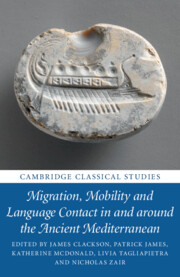Book contents
- Migration, Mobility and Language Contact in and around the Ancient Mediterranean
- Cambridge Classical Studies
- Migration, Mobility and Language Contact in and around the Ancient Mediterranean
- Copyright page
- Dedication
- Contents
- Figures
- Tables
- Contributors
- Acknowledgements
- Abbreviations of Ancient Authors and Works
- Abbreviations of Modern Sources
- Chapter 1 Introduction
- Chapter 2 Interethnic Mobility and Integration in Pre-Roman Etruria
- Chapter 3 Elusive Migrants of Ancient Italy
- Chapter 4 The Language of Mobile Craftsmen in the Western Mediterranean
- Chapter 5 Lost – and Found – in Transmission
- Chapter 6 Mobility and Orthography
- Chapter 7 The Mamertini in Messina
- Chapter 8 Migration, Identity, and Multilingualism in Late Hellenistic Delos
- Chapter 9 Interpretes, Negotiatores and the Roman Army
- Chapter 10 HOC PRIMVS VENIT
- Chapter 11 Population, Migration and Language in the City of Rome
- References
- Index Locorum
- Subject Index
Chapter 11 - Population, Migration and Language in the City of Rome
Published online by Cambridge University Press: 12 May 2020
- Migration, Mobility and Language Contact in and around the Ancient Mediterranean
- Cambridge Classical Studies
- Migration, Mobility and Language Contact in and around the Ancient Mediterranean
- Copyright page
- Dedication
- Contents
- Figures
- Tables
- Contributors
- Acknowledgements
- Abbreviations of Ancient Authors and Works
- Abbreviations of Modern Sources
- Chapter 1 Introduction
- Chapter 2 Interethnic Mobility and Integration in Pre-Roman Etruria
- Chapter 3 Elusive Migrants of Ancient Italy
- Chapter 4 The Language of Mobile Craftsmen in the Western Mediterranean
- Chapter 5 Lost – and Found – in Transmission
- Chapter 6 Mobility and Orthography
- Chapter 7 The Mamertini in Messina
- Chapter 8 Migration, Identity, and Multilingualism in Late Hellenistic Delos
- Chapter 9 Interpretes, Negotiatores and the Roman Army
- Chapter 10 HOC PRIMVS VENIT
- Chapter 11 Population, Migration and Language in the City of Rome
- References
- Index Locorum
- Subject Index
Summary
Recent studies have evaluated the patterns and extent of migration to Rome and highlighted the presence of groups with different, but intersecting, social, cultural and legal statuses. In the late Republic and Early Empire there was a continual influx of foreigners from Italy and further afield, both slaves and free, leading to ancient and modern characterisations of the city as a diverse and multicultural cosmopolis. In the late second or early third century AD, Athenaeus described Rome as ‘the epitome of the whole world’, the city that contained all others within it. Edwards’ and Woolf’s volume, Rome the Cosmopolis, opens with the spectacle of the games at the Colosseum, the spectators coming from right across the Roman Empire: ‘Marked out by their exotic clothing and hair arrangements, their incomprehensible speech, these people embodied the vastness and diversity of Roman territory, their presence in the heart of the city underlining Rome’s power to draw people to itself’. Language is here given as one of the markers of the city’s cosmopolitan character.
- Type
- Chapter
- Information
- Publisher: Cambridge University PressPrint publication year: 2020
- 2
- Cited by

